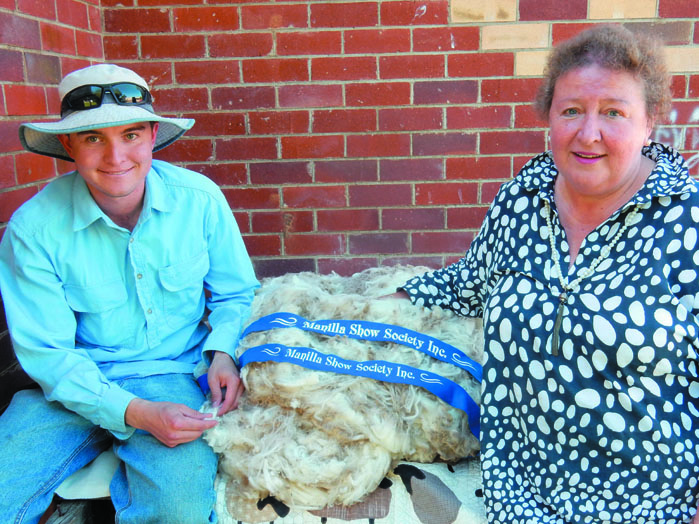
Manilla’s Glenys and Tim McDonald prepare their display of medium Merino wool for this weekend’s annual show, the mother and son could easily be reminiscing over successes the family has achieved with its fine fleeces for four generations.
Production of Woodlands’ 19-micron wool began way back in the late 1880s by Tim’s great grandfather (John Sidney McDonald), then continued on by the family through his son Ray McDonald, grandson the late Peter McDonald and now Tim, who helps mum Glenys do the hard yards in his spare hours away from his employment with Tamworth Regional Council at its Manilla Water and Waste Water Depot.
Exhibiting at the annual Manilla Show is something the McDonald family takes a lot of pride in, according to Glenys.
“Pete (who died in 2016) and I would have been married 31 years, and we’ve shown fleeces all that time. The family was involved in the show for many, many years prior to that. Pete and I also ran the wool section here for nearly 30 years,” she said. “We’ve had a lot of successes, both here and at closer regional shows, but supporting our own local show and community is what it’s all about. It’s nice to support the smaller rural shows. It has a good name around the show circuit. A lot of people we talk to consider Manilla as the Royal of the North. It’s just a classic old country show.”
Along with their 1000 breeding ewes, the McDonalds also run Hereford cattle, but the love of lanolin certainly flows through the McDonald veins, according to Tim. “We’ve always had cattle too, but dad had a soft spot for the sheep. If things got tough as in drought, sheep always took preference over the cattle.” The family uses local shearers for the annual shearing task, and sell their wool in Sydney after it’s gone through the process of testing locally. “It’s trucked into Tamworth where it’s core tested from samples pulled from the bales,” Tim said.
Maintaining a good line of fleeces is guaranteed by the use of good bloodlines too, according to Glenys
“For as long as I can remember, we’ve used Peter Capel’s Bungulla rams.”
Producing good wool though comes with a lot of hard and consistent work. Tim and his mum both agree on the importance of securing a good fleece which is “nice in colour, has a soft handle, is sound and not tender (as in breakages), trueness to type, evenness, has a good weight and is minimal in vegetable matter”.
Glenys added “the sheep must be placed into clean paddocks – if there’s seed, then slash first, burr control too is very important”.
Tim’s key to success is having a good animal health program in place.
“Animal nutrition must be looked after, if they’re well-nourished, it’ll create a good sound fleece. Worms, lice and fly must be kept,under control also,” he said.
Losing her husband of nearly three decades transferred a lot of responsibility onto Glenys “I always looked after the kids (Tim and younger sister Emily) and the home while Pete looked after the farm (of nearly 3000 acres). After he’d gone though, I had to step up and learn everything about running the farm. It’s been a long hard slog – the drought was horrendous,” Glenys said.
Away from farming chores, Glenys (a retired textile design/food technology teacher) enjoys attending her twice-monthly sewing group in Barraba. Tim, when he’s not tinkering with his metal art, is running onto the soccer field with his beloved Manilla Hornets.
.


